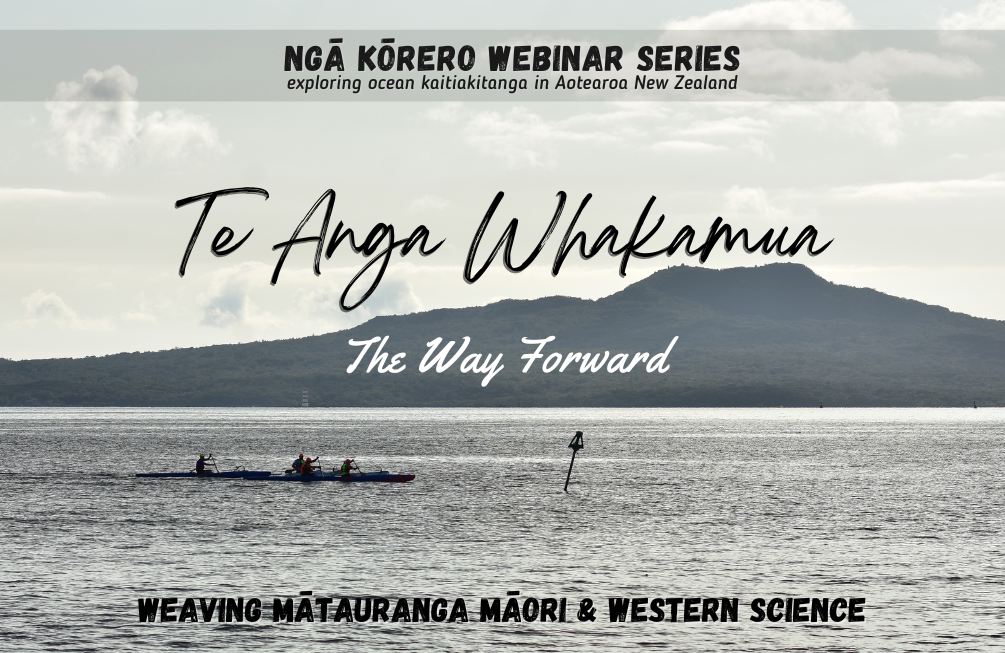
The sixth webinar of the Ngā Kōrero series put a spotlight on work that weaves Mātauranga Māori (indigenous knowledge) with science for positive outcomes for te moana.
Thank you to our incredible speakers Dr. Dan Hikuroa, Dr. Kimberley Maxwell and Dr. Maui Hudson.
Mauri and Taonga
Dr. Dan Hikuroa is a Senior Lecturer in Māori Studies, Te Wānanga o Waipapa, at the University of Auckland, where he is also part of the executive team at Te Ao Mārama – Centre for Fundamental Inquiry. Throughout his career, Dr. Hikuroa has explored the similarities and differences between indigenous knowledges and science. Dan set the scene for this webinar by reviewing what mauri is and how mauri is impacted.
Many human activities can contribute to the loss or degradation of mauri - which is 'the life-supporting capacity of the waters and environments’ in Māori culture. The mauri is likened to an indicator of the health of a place, its something you can see and feel when it is compromised. Talking about mauri led to Dan defining to another reo word connected to this, Kaitiakitanga, which he says is best conceptualised as 'maintaining the balance of mauri or revitalising mauri when its required.'
Dan goes on to use the wreck of the Rena on Astrolabe reef as an example to tell the story about how when mauri becomes degraded then the tapu (sacredness) is raised. This is when a mechanism to restore the mauri is needed, like the rāhui, a temporary restriction.
To introduce the concept of taonga Dr. Hikuroa uses another relevant example; kina barrens. While considering taonga ‘treasure’, isn’t incorrect, Dan says this doesn’t fully encompass the relational component of taonga. The important part is realising that the (unhealthy) kina from barrens are unsuitable as food – so they would no longer be considered taonga since the value of the kina is in our ability to enjoy it as kai and offer it to guests – part of manaakitanga.
“Taonga is more about the relationship and the value that a particular community (hapu/iwi) place on a species, rather than having an ecological component to it.”
Dan closes by connecting the terms; when the mauri of mahinga kai becomes impacted, you place a rāhui over it, until the mauri bounces back. He ties this into another modern example, noting the Ngāti Paoa rāhui on Waiheke protecting koura (crayfish), pāua, kūtai (mussels), and tipa (scallops). He notes that in the past, iwi would have placed a rahui before the resources were heavily depleted so in this situation – the mauri might take longer to bounce back.
Mātauranga in marine planning
Dr. Kimberley Maxwell is a post-doctoral research fellow in Te Kotahi Research Institute at the University of Waikato. She is a marine biologist with experience in fisheries and aquaculture and is currently working on the Moana Project. Kimberley introduced the audience to Waka-taurua, a metaphorical framework to guide collaborations between different groups. The framework is designed to be utilised when people come together to achieve a common goal.
Mātauranga Māori is the process of sharing information, and Kimberley has studied some of the ways that the framework can be applied in a practical sense to help iwi partners. Some of the work in progress is developing a coast and ocean plan and iwi impact assessment framework for Whakatōhea rohe moana, a Māori iwi located in the eastern Bay of Plenty region.
Mātauranga and ethics
Dr. Maui Hudson our the last presenter, is also involved in the Moana Project, he is an associate professor at the University of Waikato, where he is Director of Te Kotahi Research Institute. His work focuses on the application of mātauranga Māori to decision-making in areas in a wide range of areas; new technologies, health, the environment and innovation. Dr. Hudson presented on what he has learned about cross-cultural knowledge exchange – weaving Mātauranga Māori and science.